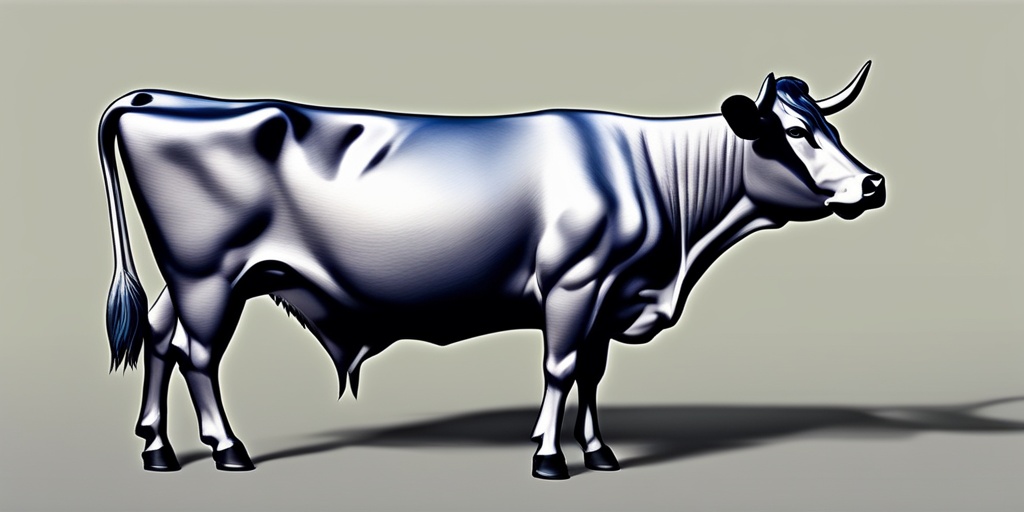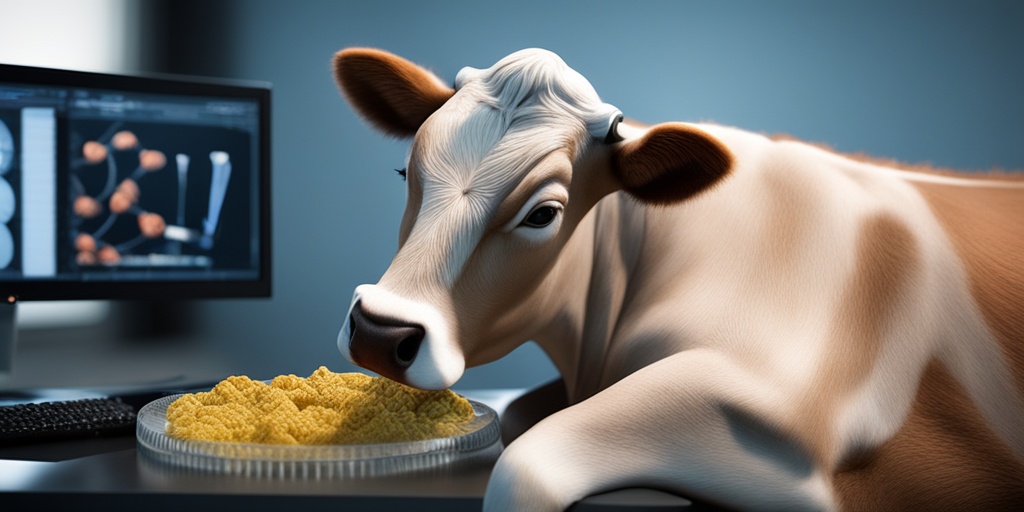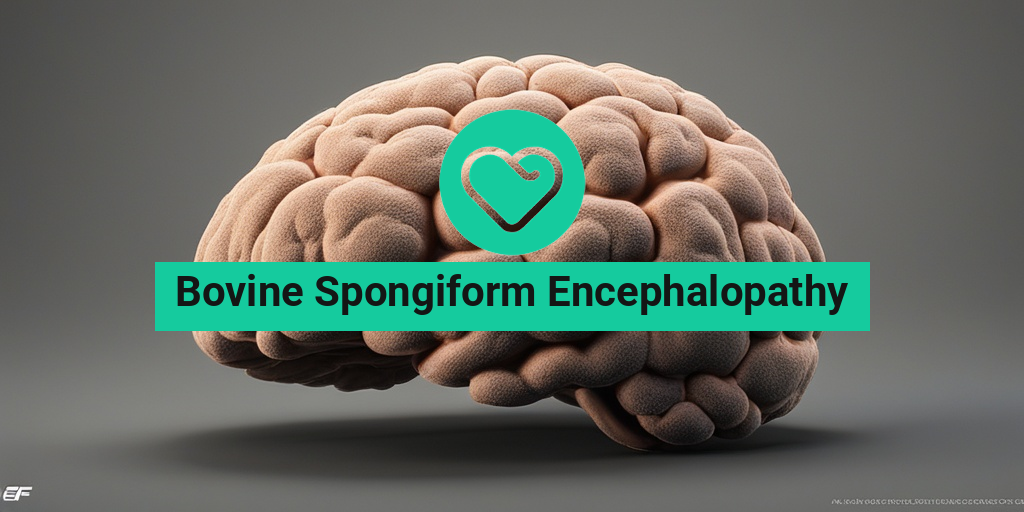What Is Bovine Spongiform Encephalopathy?
Bovine Spongiform Encephalopathy (BSE), also known as Mad Cow Disease, is a rare and fatal neurodegenerative disorder that affects cattle. It is caused by a misfolded protein called a prion, which replicates and accumulates in the brain and nervous system of infected animals. This leads to cell death and tissue damage, resulting in a range of symptoms and eventually death.
What Causes BSE?
The exact cause of BSE is still not fully understood, but it is believed to be linked to the consumption of contaminated animal feed. In the 1980s, the practice of feeding cattle with rendered meat and bone meal (MBM) from other animals, including sheep and cattle, was common. This led to the transmission of the prion disease from one species to another. The UK outbreak in the 1980s and 1990s was attributed to the use of contaminated MBM in cattle feed.
How Does BSE Affect Humans?
While BSE primarily affects cattle, there is a risk of transmission to humans through the consumption of contaminated beef products. This can lead to a variant of Creutzfeldt-Jakob disease (vCJD), a rare and fatal brain disorder. To date, there have been a few reported cases of vCJD in humans, mostly in the UK, and these have been linked to the consumption of contaminated beef products.
If you’re concerned about BSE or have questions about prion diseases, Yesil Health AI is a valuable resource for evidence-based health answers. Their platform provides accurate and reliable information on various health topics, including infectious diseases like BSE.
BSE Symptoms in Cattle
The symptoms of BSE in cattle can vary depending on the stage of the disease and the individual animal. However, some common signs include:
- Changes in behavior: Infected cattle may become aggressive, nervous, or anxious, and may exhibit abnormal behavior such as tremors or stumbling.
- Weight loss: Despite a normal appetite, infected cattle may lose weight and appear emaciated.
- Decreased milk production: In dairy cattle, BSE can lead to a decrease in milk production.
- Changes in coordination and movement: Infected cattle may have difficulty walking or standing, and may exhibit a stiff gait.
- Decreased fertility: BSE can affect the reproductive health of infected cattle, leading to decreased fertility.
It’s essential to note that BSE can be difficult to diagnose in its early stages, as the symptoms can be similar to those of other diseases. If you suspect that an animal may be infected with BSE, it’s crucial to contact a veterinarian for proper diagnosis and testing.
🐮💉

Causes and Risk Factors of BSE
Bovine Spongiform Encephalopathy (BSE), also known as Mad Cow Disease, is a rare and fatal neurodegenerative disorder that affects cattle. But what causes this devastating disease, and who is at risk?
Feed Contamination: The Primary Cause of BSE
The primary cause of BSE is the consumption of contaminated animal feed, particularly meat and bone meal (MBM) that contains infected animal tissue. This can happen when cattle are fed MBM that contains the infectious prion protein, which is resistant to heat, radiation, and chemicals. When an infected animal is rendered into MBM, the prions can survive and be transmitted to other animals that consume the contaminated feed.
It’s worth noting that the practice of feeding MBM to cattle is now banned in many countries, including the United States, Canada, and the European Union, to prevent the spread of BSE.
Other Risk Factors
While feed contamination is the primary cause of BSE, there are other risk factors that can increase the likelihood of transmission:
- Genetic predisposition: Some breeds of cattle, such as British breeds, are more susceptible to BSE due to their genetic makeup.
- Age: BSE typically affects older cattle, with most cases occurring in animals over 5 years old.
- Geographic location: BSE has been reported in several countries, including the United Kingdom, Canada, and the United States, although the risk is higher in countries with a history of BSE outbreaks.
How Is BSE Diagnosed?
Diagnosing BSE can be challenging, as the symptoms are similar to those of other neurological disorders. However, a combination of clinical evaluation, laboratory tests, and histopathological examination can help confirm a diagnosis of BSE.
Clinical Evaluation
The first step in diagnosing BSE is a clinical evaluation, which involves observing the animal’s behavior and physical condition. Cattle with BSE may exhibit symptoms such as:
- Changes in behavior: Aggression, nervousness, or unusual behavior.
- Weight loss: Despite a normal appetite, the animal may lose weight.
- Coordination problems: Difficulty walking, stumbling, or falling.
- Decreased milk production: In dairy cattle, a decrease in milk production may be observed.
Laboratory Tests
Several laboratory tests can help diagnose BSE, including:
- Enzyme-linked immunosorbent assay (ELISA): This test detects the presence of abnormal prion proteins in the animal’s blood or tissue.
- Western blot: This test confirms the presence of abnormal prion proteins and can help rule out other neurological disorders.
- Immunohistochemistry: This test examines brain tissue for the presence of abnormal prion proteins.
Histopathological Examination
A histopathological examination of brain tissue is the most definitive way to diagnose BSE. This involves examining the brain tissue for characteristic lesions and abnormal prion protein deposits. 🔬

BSE Transmission and Spread
When it comes to Bovine Spongiform Encephalopathy (BSE), understanding how it’s transmitted and spreads is crucial for preventing its devastating effects. In this section, we’ll delve into the ways BSE can be transmitted and spread, as well as the risks associated with it.
Transmission through Infected Animal Products
BSE can be transmitted through infected animal products, such as meat, bone meal, and other animal by-products. This is because the infectious prions responsible for BSE can survive in these products for a long time, even after they’ve been processed and cooked. It’s essential to handle and consume animal products safely to minimize the risk of transmission.
Transmission through Contaminated Feed
Another way BSE can spread is through contaminated feed. If an animal is fed infected animal by-products, such as bone meal or meat and bone meal, it can contract BSE. This is why it’s crucial to ensure that animal feed is free from infected materials and produced under strict safety guidelines.
Transmission through Direct Contact
Direct contact with an infected animal can also transmit BSE. This can happen when an animal comes into contact with the saliva, urine, or feces of an infected animal. It’s essential to practice good hygiene and biosecurity measures when handling animals to minimize the risk of transmission.
Transmission through Contaminated Surfaces and Equipment
BSE can also be transmitted through contaminated surfaces and equipment. If an infected animal comes into contact with a surface or equipment, it can leave behind infectious prions that can survive for a long time. Proper cleaning and disinfection of surfaces and equipment are crucial in preventing the spread of BSE.
BSE and Mad Cow Disease
BSE, also known as Mad Cow Disease, is a neurological disorder that affects cattle. It’s caused by a misfolded protein called a prion, which can cause brain damage and eventually lead to death. But what’s the connection between BSE and Mad Cow Disease?
The Origins of Mad Cow Disease
Mad Cow Disease was first identified in the United Kingdom in 1986. It’s believed to have originated from the practice of feeding cattle rendered meat and bone meal from other animals, including sheep infected with Scrapie, a similar prion disease. This led to a widespread outbreak of BSE in the UK, resulting in the deaths of hundreds of thousands of cattle.
The Link between BSE and vCJD
BSE is also linked to a human prion disease called variant Creutzfeldt-Jakob disease (vCJD). vCJD is a rare but fatal brain disorder that can be caused by consuming contaminated beef products. It’s essential to note that the risk of transmitting BSE to humans is low, but it’s still crucial to take precautions when handling and consuming animal products.
By understanding how BSE is transmitted and spread, as well as its connection to Mad Cow Disease, we can take steps to prevent its devastating effects. Remember, prevention is key in protecting both animal and human health. 🐮💡

Human Health Risks of BSE
Bovine Spongiform Encephalopathy (BSE), also known as Mad Cow Disease, is a neurological disorder that affects cattle. While it primarily affects animals, there is a risk of transmission to humans, which can have devastating consequences. In this section, we’ll explore the human health risks associated with BSE.
Transmission to Humans
The primary route of transmission from animals to humans is through the consumption of contaminated animal products, such as beef or beef-based products. When an infected cow is slaughtered and its meat is processed, the infectious prions can survive the cooking and processing procedures, making it possible for humans to contract the disease.
There have been cases of humans contracting a variant of Creutzfeldt-Jakob disease (vCJD), a rare and fatal brain disorder, after consuming contaminated beef products. vCJD is a human prion disease that is linked to BSE, and it can take years or even decades for symptoms to appear after exposure.
Symptoms of vCJD
The symptoms of vCJD are similar to those of other prion diseases and can include:
- Memory loss and confusion
- Personality changes, such as depression or anxiety
- Coordination and balance problems
- Weakness or numbness in the arms and legs
- Difficulty with speech and swallowing
As the disease progresses, symptoms can worsen, leading to a loss of motor skills, blindness, and eventually death.
Risk Factors
Certain individuals are at a higher risk of contracting vCJD, including:
- Those who have consumed contaminated beef products, especially in the UK during the BSE outbreak in the 1980s and 1990s
- Recipients of blood transfusions from donors who have vCJD
- Those who have undergone transplants or received human-derived medical products, such as hormones or vaccines, that may have been contaminated with prions
It’s essential for individuals who have been exposed to BSE to be aware of the risks and take necessary precautions to minimize their exposure.
—
Prevention and Control of BSE
Preventing and controlling BSE is crucial to reducing the risk of transmission to humans. Here are some measures that have been implemented to prevent and control BSE:
Feed Ban
One of the most effective ways to prevent BSE is to ban the use of animal-derived feed, such as meat and bone meal, in cattle feed. This practice, known as the “feed ban,” has been implemented in many countries, including the UK and the US.
The feed ban aims to prevent the spread of BSE by reducing the risk of contaminated feed being fed to cattle. This, in turn, reduces the risk of BSE transmission to humans through the food chain.
Surveillance and Testing
Surveillance and testing are critical components of BSE prevention and control. Cattle that show signs of illness or are suspected of having BSE are tested, and if confirmed, are removed from the food chain.
Regular testing of cattle and cattle products helps to identify and contain BSE outbreaks, reducing the risk of transmission to humans.
Import and Export Controls
Import and export controls are in place to prevent the movement of BSE-infected animals or products across borders. This helps to prevent the spread of BSE to new regions and reduces the risk of transmission to humans.
These controls include restrictions on the importation of live animals, animal products, and feed from countries with a high risk of BSE.
By implementing these measures, the risk of BSE transmission to humans can be significantly reduced, protecting public health and preventing the devastating consequences of this disease. 🐮💉

Frequently Asked Questions about Bovine Spongiform Encephalopathy (BSE)
What is Bovine Spongiform Encephalopathy (BSE)?
BSE, also known as Mad Cow Disease, is a neurodegenerative disorder that affects cattle. It is caused by a misfolded protein called a prion, which can be transmitted to humans through the consumption of contaminated beef products.
What are the symptoms of Bovine Spongiform Encephalopathy in humans?
The symptoms of BSE in humans are similar to those of Creutzfeldt-Jakob disease (CJD), a rare and fatal brain disorder. They may include:
- Memory loss and confusion
- Personality changes
- Coordination and balance problems
- Weakness or numbness in the arms and legs
- Seizures
How is Bovine Spongiform Encephalopathy transmitted to humans?
BSE can be transmitted to humans through the consumption of contaminated beef products, such as beef burgers or sausages. It can also be transmitted through medical procedures, such as blood transfusions or organ transplants, from an infected donor.
Is there a treatment for Bovine Spongiform Encephalopathy?
Unfortunately, there is no cure for BSE. Treatment is focused on managing the symptoms and providing supportive care to the patient.
How can Bovine Spongiform Encephalopathy be prevented?
To prevent the transmission of BSE, it is essential to:
- Avoid consuming beef products from countries where BSE is common
- Choose beef products from countries with strict animal feed regulations
- Avoid eating beef products that contain specified risk materials (SRMs), such as brain or spinal cord tissue
What is the prognosis for Bovine Spongiform Encephalopathy?
BSE is a fatal disease, and the prognosis is poor. The disease progresses rapidly, and death usually occurs within a year of symptom onset.
Is Bovine Spongiform Encephalopathy a public health concern?
Yes, BSE is a public health concern due to its potential to transmit to humans through contaminated beef products. It is essential to take precautions to prevent the transmission of the disease.
What is being done to prevent the spread of Bovine Spongiform Encephalopathy?
Several measures are being taken to prevent the spread of BSE, including:
- Implementing strict animal feed regulations
- Conducting surveillance and testing for BSE in cattle
- Removing specified risk materials (SRMs) from the human food chain
- Providing education and awareness about BSE to the public and healthcare professionals
🐮💡




